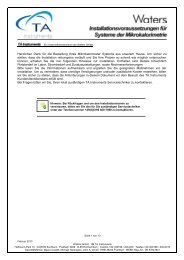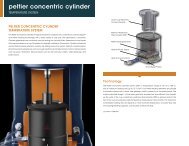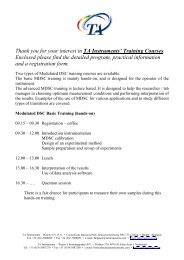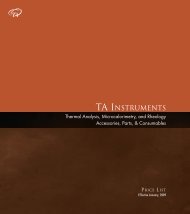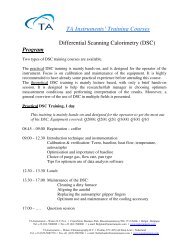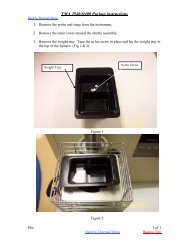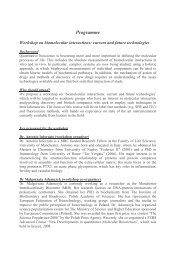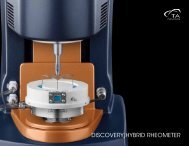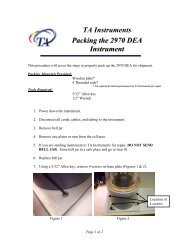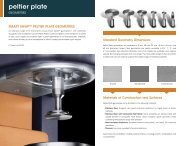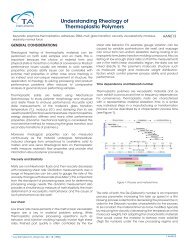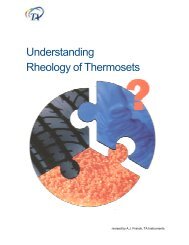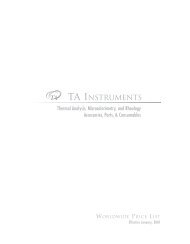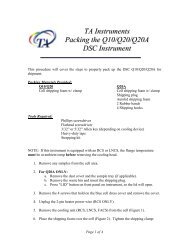Nano DSC Brochure - TA Instruments
Nano DSC Brochure - TA Instruments
Nano DSC Brochure - TA Instruments
Create successful ePaper yourself
Turn your PDF publications into a flip-book with our unique Google optimized e-Paper software.
nano <strong>DSC</strong> automatioN<br />
nano <strong>DSC</strong> applications<br />
The <strong>Nano</strong> <strong>DSC</strong> Autosampler system enables true “start and walk away” capability<br />
without sacrificing either sensitivity or reliability. The autosampler stores samples and<br />
the matching buffers/solvents in a 96-well plate format at temperatures ranging from<br />
4°C to ambient room temperature. Four (4) wash/rinse solvents are accessible through<br />
programmable ports on the autosampler interface. Two (2) exit ports enable the<br />
collection of sample and matching buffer/solvent solutions from both the sample or<br />
reference cell of the <strong>Nano</strong> <strong>DSC</strong>.<br />
For molecular stability testing applications that require high sample throughput, the<br />
<strong>Nano</strong> <strong>DSC</strong> Autosampler system is a reliable sample handling system that increases<br />
the productivity of the most sensitive <strong>DSC</strong> on the market with true walk-away capability<br />
and proven reliability.<br />
The figure shows overlapping plots of <strong>DSC</strong> scans of duplicate samples of five different<br />
Lysozyme sample concentrations when converted to Molar Heat Capacity. The <strong>Nano</strong><br />
<strong>DSC</strong> Autosampler system produces superior data reproducibility and precision at<br />
low sample concentrations with no detectable sample-to-sample carry-over or sample<br />
degradation.<br />
Molar Heat Capacity (kcal/mol-K)<br />
18<br />
16<br />
14<br />
12<br />
10<br />
8<br />
6<br />
44 46 48 50 52 54 56<br />
Temperature ˚C<br />
58 60 62 64<br />
How much Protein is Required<br />
for a <strong>DSC</strong> Scan<br />
Determining the thermodynamic parameters of a protein by<br />
differential scanning calorimetry (<strong>DSC</strong>) using the <strong>Nano</strong> <strong>DSC</strong><br />
requires about the same amount of protein as surface<br />
plasmon resonance or fluorescence studies. Because of the<br />
<strong>Nano</strong> <strong>DSC</strong>’s extreme sensitivity and baseline reproducibility,<br />
and the sample cell’s small volume (300 µL), a complete,<br />
interpretable, accurate scan can be obtained on essentially<br />
any protein of interest. The sensitivity and accuracy of the<br />
<strong>Nano</strong> <strong>DSC</strong> is demonstrated by this data. Hen egg white<br />
lysozyme (in pH 4.0 glycine buffer) was prepared at various<br />
concentrations. As little as 2 µg of lysozyme in the capillary<br />
cell is sufficient to provide quality data yielding accurate<br />
values of all four thermodynamic parameters!<br />
Molar Heat Capacity<br />
2 µg<br />
5 µg<br />
10 µg<br />
25 µg<br />
50 µg<br />
100 µg<br />
400 µg<br />
55 60 65 70 75 80 85 90 90<br />
Temperature (˚C)<br />
Lysozyme Calorimetric van’t Hoff<br />
in cell (µg) DH (kJ mol -1 ) DS (kJ K -1 mol -1 ) T m (°C) DH (kJ mol -1 )<br />
400 512 1.46 78.0 515<br />
100 512 1.46 78.0 509<br />
50 517 1.47 77.9 513<br />
25 513 1.46 77.8 513<br />
10 515 1.47 78.0 515<br />
5 490 1.40 78.0 510<br />
2 503 1.43 77.8 499<br />
18<br />
19



